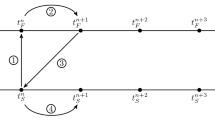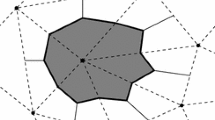Abstract
An adaptation procedure using refinement, coarsening and smoothing with anisotropic considerations for unstructured meshes and its coupling with a compressible flow solver is presented in this work. The developed refinement strategy combines a Riemannian centred split of the edges. The coarsening methodology uses an edge collapse procedure where the collapse point is evaluated using anisotropic quality considerations. An accurate and anisotropic vertex smoothing algorithm that operates along the direction of the edges is presented. Edge and face swapping are also used together with the refinement coarsening and smoothing strategies to enhance anisotropic quality. The developed approach makes use of only simple mesh information and is applicable to two and three-dimensional meshes. The performance of the methodology is analysed for two-dimensional triangular meshes and three-dimensional tetrahedral meshes on analytical test cases and to solve steady-state inviscid compressible flows. The transonic flow past an airfoil, the supersonic flow around a sphere and the flow around a complex real-life application are performed.


















Similar content being viewed by others
References
Frey PJ, Alauzet F (2005) Anisotropic mesh adaptation for CFD computations. Comput Methods Appl Mech Eng 194(48–49):5068–5082
Stein E, Rust W (1991) Mesh adaptations for linear 2d finite-element discretizations in structural mechanics, especially in thin shell analysis. J Comput Appl Math 36(1):107–129
Klein RI (1999) Star formation with 3-D adaptive mesh refinement: the collapse and fragmentation of molecular clouds. J Comput Appl Math 109(1–2):123–152
Frey PJ (2004) Generation and adaptation of computational surface meshes from discrete anatomical data. Int J Numer Methods Eng 60(6):1049–1074
Castro-Diaz MJ, Hecht F, Mohammadi B, Pironneau O (1997) Anisotropic unstructured mesh adaptation for flow simulation. Int J Numer Methods Fluids 25(4):475–491
Vallet MG (1992) Generation de maillages elements finis anisotropes et adaptatifs. Ph.D. Thesis, Universite Pierre et Marie Currie, Paris VI, France
Loseille A, Alauzet F (2011) Continuous mesh framework part I: well-posed continuous interpolation error. SIAM J Numer Anal 49(1):38–60
Bottasso CL (2004) Anisotropic mesh adaption by metric-driven optimization. Int J Numer Methods Eng 60(3):597–639
Alauzet F (2014) A changing-topology moving mesh technique for large displacements. Eng Comput 30(2):175–200
Alexandra C, Ducrot V (2009) Levelsets and anisotropic mesh adaptation. Discrete Contin Dyn Syst 23(1–2):165–183
Loseille A, Löhner R (2009) On 3D anisotropic local remeshing for surface, volume, and boundary layers. In: Proceedings in 18th international meshing roundtable, Springer-Verlag, Salt-Lake City, UT, USA, pp 611–630
Quan D-L, Toulorge T, Bricteux G, Remacle J-F, Marchandise E (2014) Anisotropic adaptive nearly body-fitted meshes for CFD. Eng Comput 30(4):517–533
Peraire J, Peiro J, Morgan K (1992) Adaptive remeshing for three dimensional compressible flow computation. J Comput Phys 103(2):269–285
Borouchaki H, George PL, Hecht F, Laug P, Saltel E (1997) Delaunay mesh generation governed by metric specificationspart I: algorithms. Finite Elements Anal Design 25(1–2):61–83
Löhner R, Baum JD (1990) Numerical simulation of shock interactions with complex geometry three-dimensional structures using a new adaptive h-refinement scheme on unstructured grids. In: Proceedings in 28th aerospace science meeting, AIAA-90-0700
Liu A, Joe B (1996) Quality local refinements of tetrahedral meshed based on 8-subtetrahedron subdivision. Math Comput 65(215):1183–1200
Rivara MC (1997) New longest-edge algorithms for the refinement and/or improvement of unstructured triangulations. Int J Numer Methods Eng 40(18):3313–3324
Bey J (1995) Tetrahedral grid refinement. Computing 55(4):355–378
Maubach JM (1995) Local bisection refinement for n-simplicial grids generated by reflection. SIAM J Sci Comput 16(1):210–227
De Cougny HL, Shephard MS (1999) Parallel refinement and coarsening of tetrahedral meshes. Int J Numer Methods Eng 46:1101–1125
Rassineux A, Breitkopf P, Villon P (2003) Simultaneous surface and tetrahedron mesh adaptation using mesh-free techniques. Int J Numer Methods Eng 57:371–389
Habashi WG, Dompierre J, Bourgault Y, Ait-Ali-Yahia D, Fortin M, Vallet MG (2000) Anisotropic mesh adaptation: towards user-independent, mesh-independent and solver independent CFD. part i: general principles (no. 6). J Numer Methods Fluids 32:725–744
Pain CC, Umpleby AP, de Oliveira CRE (2001) Tetrahedral mesh optimization and adaptivity for steady-state and transient finite element calculations. Comput Methods Appl Mech Eng 190:3771–3796
Waltz J (2004) Parallel adaptive refinement for unsteady flow calculations on 3D unstructured grids. Int J Numer Methods Fluids 46:37–57
Rivara M-C (1989) Selective refinement/derefinement algorithms for sequences of nested triangulations. Int J Numer Methods Eng 28(12):2889–2906
Ollivier-Gooch C (2003) Coarsening unstructured meshes by edge contraction. Int J Numer Methods Eng 57(3):391–414
Walter MAT, Abdu AAQ, da Silva LFF, Azevedo JL (2005) Evaluation of adaptive mesh refinement and coarsening for the computation of compressible flow on unstructured meshes. Int J Numer Methods Fluids 49(9):999–1014
Jones MT, Plassmann PE (1997) Adaptive refinement of unstructured finite-element meshes. Finite Elements Anal Design 25(1–2):41–60
Li X, Shephard MS, Beall MW (2003) Accounting for curved domains in mesh adaptation. Int J Numer Methods Eng 58(2):247–276
Freitag LA, Ollivier-Gooch C (1997) Tetrahedral mesh improvement using swapping and smoothing. Int J Numer Methods Eng 40(21):3979–4002
Tam A, Ait-Ali-Yahia D, Robichaud MP, Moore M, Kozel V, Habashi WG (2000) Anisotropic mesh adaptation for 3d flows on unstructured grids. Comput Methods Appl Mech Eng 189(4):1025–1230
Sastry SP, Shontz SM (2012) Performance characterization of nonlinear optimization methods for mesh quality improvement. Eng Comput 28(3):269–286
Jones W, Nielsen E, Park M (2006) Validation of 3d adjoint based error estimation and mesh adaptation for sonic boom prediction. In: Proceedings in 44th aerospace science meeting and exhibit, AIAA-2006-1150
Alauzet F, Olivier G (2011) Extension of metric-based anisotropic mesh adaptation to time-dependent problems involving moving geometries. In: Proceedings in 49th aerospace science meeting and exhibit, AIAA-2011-0896
Zienkiewicz OC, Codina R (1995) A general algorithm for compressible and incompressible flow-part I: the split, characteristic-based scheme. Int J Numer Methods Fluids 20(8–9):869–885
Zienkiewicz OC, Taylor RL, Nithiarasu P (2005) The finite element method for fluid dynamics, 6th edn. Butterworth-Heinemann, Oxford
Vallet MG, Manole CM, Dompierre J, Dufour S, Guibault F (2007) Numerical comparison of some Hessian recovery techniques. Int J Numer Methods Eng 72(8):987–1007
Loseille A, Alauzet F (2009) Optimal 3D highly anisotropic mesh adaptation based on the continuous mesh framework. In: Proceedings in 18th international meshing roundtable, Springer-Verlag, Salt-Lake City, UT, USA, pp 575–594
Ruprecht D, Muller H (1998) A Scheme for edge-based adaptive tetrahedron subdivision. Mathematical visualization. Springer, Berlin
Alauzet F, Mehrenberger M (2010) P1-conservative solution interpolation on unstructured triangular meshes. Int J Numer Methods Eng 84(13):1552–1588
Farrell PE, Piggott MD, Pain CC, Gorman GJ, Wilson CR (2009) Conservative interpolation between unstructured meshes via supermesh construction. Comput Methods Appl Mech Eng 84(33–36):2632–2642
Nithiarasu P, Codina R, Zienkiewicz OC (2006) The characteristic-based split (CBS) scheme-a unified approach to fluid dynamics. Int J Numer Methods Eng 66(10):1514–1546
Nithiarasu P, Zienkiewicz OC, Satya-Sai BVK, Morgan K, Vzquez M (1998) Shock capturing viscosities for the general fluid mechanics algorithm. Int J Numer Methods Fluids 28(9):1325–1353
Hetmaniuk U, Knupp P (2011) A mesh optimization algorithm to decrease the maximum interpolation error of linear triangular finite elements. Eng Comput 27(1):3–15
Yoshihara H, Sacher P (1985) Test cases for Inviscid flow field methods. AGARD-AR-221, Paris
Bailey A, Hiatt J (1971) Free-flight measurements of sphere drag at subsonic, transonic, supersonic, and hypersonic speeds for continuum, transition, and near free molecular flow conditions. Arnold Engng Development Ctr., Arnold Air Force Station, TN, Rep. AEDC-TR-70-291
Charters A, Thomas R (1945) The aerodynamic performance of small spheres from subsonic to high supersonic velocities. J Aeronaut Sci 12(4):468–476
Nazarov N, Hoffman J (2010) An adaptive finite element method for inviscid compressible flow. Int J Numer Methods Fluids 64(10–12):1102–1128
Acknowledgements
The authors wish to thank to CAPES and CNPq (Brazilian Research Committees) for their financial support and they thank also to CESUP (UFRGS Supercomputing Center) for its important contributions.
Author information
Authors and Affiliations
Corresponding author
Rights and permissions
About this article
Cite this article
Linn, R.V., Awruch, A.M. Edge-based anisotropic mesh adaptation of unstructured meshes with applications to compressible flows. Engineering with Computers 33, 1007–1025 (2017). https://doi.org/10.1007/s00366-017-0513-2
Received:
Accepted:
Published:
Issue Date:
DOI: https://doi.org/10.1007/s00366-017-0513-2




